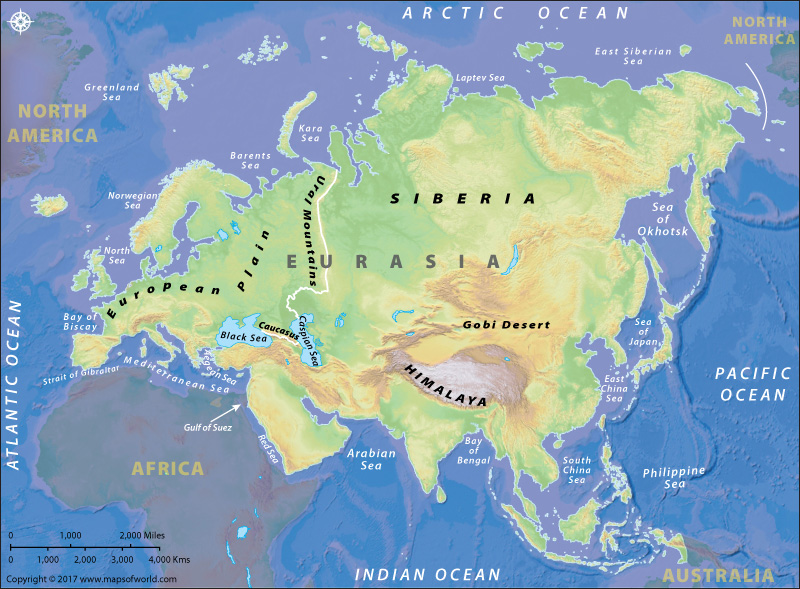What is Eurasia?

Geographers follow specific criteria to determine what qualifies as a continent. A primary rule is whether a landmass resides on its distinct section of the Earth’s crust, known as a tectonic plate. By this standard, Eurasia would be regarded as a single continent. In this article, we’ll explore What is Eurasia, where it is, interesting facts, and more.
Eurasia
Eurasia is a huge landmass that includes both Europe and Asia. Many people live there, with a variety of cultures, languages, and religions. Some of the world’s greatest ancient civilizations, like Mesopotamia, the Indus Valley, Ancient China, Ancient Greece, and Rome, started in Eurasia. This diversity and connection make Eurasia important in history and today’s world.
Eurasia covers 55 million square kilometers, making up 36% of the world’s land area. It includes both the mainland and many islands, like the United Kingdom, the Philippines, Japan, and Indonesia.
Eurasia has many different ecosystems and landforms. It has the Gobi Desert, the Himalayas, the European Plain, and the Mediterranean Coast. It also has cold areas in Siberia and warm beaches along the Indian Ocean. Because of this, Eurasia has almost all types of climates.
The variety of climates and habitats in Eurasia means it is home to many animals. Some important animals are the Siberian tiger and Amur leopard in Russia, the giant panda in China, and the snow leopard in Central and South Asia. The European bison lives in Poland and Belarus, and the Asian elephant lives in Southeast Asia. Other common animals include the brown bear, red fox, saiga antelope, and yak.
Where is Eurasia?
Eurasia is in the Northern Hemisphere and includes Europe and Asia. It stretches from the Atlantic Ocean in the west to the Pacific Ocean in the east. The Arctic Ocean is to the north, and the Indian Ocean is to the south.
The border between Europe and Asia runs along the Ural Mountains and Ural River, through the Caspian Sea, and across the Caucasus Mountains. Eurasia includes many countries, such as France and Germany in the west and China and Japan in the east. Eurasia’s geographical coordinates are 45.4507° N, and 68.8319° E.
Countries in Eurasia
Following is the list of countries organized by their continental region within Eurasia:
Countries in Europe
- Albania
- Andorra
- Armenia
- Austria
- Azerbaijan
- Belarus
- Belgium
- Bosnia and Herzegovina
- Bulgaria
- Croatia
- Cyprus
- Czech Republic
- Denmark
- Estonia
- Finland
- France
- Georgia
- Germany
- Greece
- Hungary
- Iceland
- Ireland
- Italy
- Kazakhstan (partly in Europe)
- Kosovo
- Latvia
- Liechtenstein
- Lithuania
- Luxembourg
- Malta
- Moldova
- Monaco
- Montenegro
- Netherlands
- North Macedonia
- Norway
- Poland
- Portugal
- Romania
- Russia (partly in Europe)
- San Marino
- Serbia
- Slovakia
- Slovenia
- Spain
- Sweden
- Switzerland
- Turkey (partly in Europe)
- Ukraine
- United Kingdom
- Vatican City
Countries in Asia
- Afghanistan
- Armenia (considered transcontinental)
- Azerbaijan (considered transcontinental)
- Bahrain
- Bangladesh
- Bhutan
- Brunei
- Cambodia
- China
- Cyprus (often considered culturally European)
- Georgia (considered transcontinental)
- India
- Indonesia (partly in Asia)
- Iran
- Iraq
- Israel
- Japan
- Jordan
- Kazakhstan (considered transcontinental)
- Kuwait
- Kyrgyzstan
- Laos
- Lebanon
- Malaysia (partly in Asia)
- Maldives
- Mongolia
- Myanmar
- Nepal
- North Korea
- Oman
- Pakistan
- Palestine
- Philippines
- Qatar
- Russia (partly in Asia)
- Saudi Arabia
- Singapore
- South Korea
- Sri Lanka
- Syria
- Tajikistan
- Thailand
- Timor-Leste
- Turkey (considered transcontinental)
- Turkmenistan
- United Arab Emirates
- Uzbekistan
- Vietnam
- Yemen
Interesting Facts About Eurasia
- Eurasia includes both, the highest point on Earth, Mount Everest (8,848 meters or 29,029 feet), and the lowest point on land, the shore of the Dead Sea (-430 meters or -1,411 feet).
- It has the longest combined coastline of any landmass, touching the Arctic, Atlantic, Indian, and Pacific Oceans.
- Eurasia includes the two most populous countries in the world, China and India, which together, account for about 36% of the global population.
- The Siberian taiga is the largest forested area in the world, covering much of northern Russia and parts of Kazakhstan, Mongolia, and China.
- It includes several of the world’s largest economies, such as those of, China, Japan, Germany, Russia, and India.
Related Links